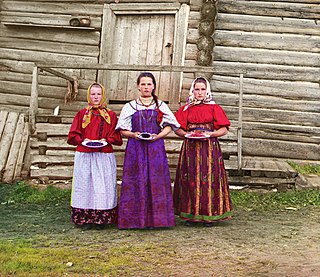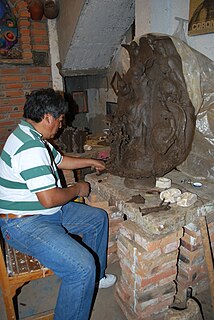
Zenón Martínez García (died 2010) was a Mexican potter from Tlaquepaque, Jalisco recognized for his figurines.

Tlaquepaque, historically San Pedro Tlaquepaque, is a city and the surrounding municipality in the Mexican state of Jalisco.

Jalisco, officially the Free and Sovereign State of Jalisco, is one of the 31 states which, with the Federal District, comprise the 32 Federal Entities of Mexico. It is located in Western Mexico and is bordered by six states which are Nayarit, Zacatecas, Aguascalientes, Guanajuato, Michoacán and Colima. Jalisco is divided into 125 municipalities, and its capital city is Guadalajara. Jalisco is one of the most important states in Mexico because of its natural resources as well as its history. Many of the characteristic traits of Mexican culture, particularly outside Mexico City, are originally from Jalisco, such as mariachi, ranchera music, birria, tequila, jaripeo, etc., hence the state's motto: "Jalisco es México." Economically, it is ranked third in the country, with industries centered in the Guadalajara metropolitan area, the second largest metropolitan area in Mexico. The state is home to two significant indigenous populations, the Huichols and the Nahuas. There is also a significant foreign population, mostly retirees from the United States and Canada, living in the Lake Chapala and Puerto Vallarta areas.
Martínez García’s work is distinguished by its realism along with expressive faces. His most notable work is that of nativity scenes. He created at least eighteen different basic sets, from the most traditional to Mexicanized versions in Chiapan, Huichol or Aztec dress or with the addition of charros, campesinos and more. He also made individual figures, also based on Mexican tradition, including bullfighters, men handling fighting roosters, street sellers, charcoal makers, and farmers. [1]

Chiapas, officially the Free and Sovereign State of Chiapas, is one of the 31 states that along with the federal district of Mexico City make up the 32 federal entities of Mexico. It is divided into 124 municipalities as of September 2017 and its capital city is Tuxtla Gutiérrez. Other important population centers in Chiapas include Ocosingo, Tapachula, San Cristóbal de las Casas, Comitán and Arriaga. It is the southernmost state in Mexico. It is located in Southeastern Mexico, and it borders the states of Oaxaca to the west, Veracruz to the northwest and Tabasco to the north, and by the Petén, Quiché, Huehuetenango and San Marcos departments of Guatemala to the east and southeast. Chiapas has a coastline along the Pacific Ocean to the south.

A charro is a traditional horseman from Mexico, originating in the central-western regions primarily in the states of Jalisco, Michoacan, Zacatecas, Durango, Chihuahua, Aguascalientes and Guanajuato. The Spanish terms vaquero and ranchero are similar to the charro but different in culture, etiquette, mannerism, clothing, tradition and social status.

A peasant is a pre-industrial agricultural laborer or farmer, especially one living in the Middle Ages under feudalism and paying rent, tax, fees, or services to a landlord. In Europe, peasants were divided into three classes according to their personal status: slave, serf, and free tenant. Peasants either hold title to land in fee simple, or hold land by any of several forms of land tenure, among them socage, quit-rent, leasehold, and copyhold.
He made his figures from a fine white clay, mixed with a sticky black, both locally obtained. Cleaning and mixing was all done by hand in his workshop, even stepping on batches of clay to eliminate air bubbles. The figures are shaped by hand, over a wire frame for support, each with slightly different face and expression. His paints consist of egg yolk, oil and water along with coloring agents, which has a mate finish. Certain elements such as eyes and hair were varnished to make them shine. [1]
He mostly sold his wares in his hometown of Tlaquepaque, but spent the Christmas season in Mexico City, selling nativity scenes at the artisans’ fair in the Balbuena neighborhood. [1]

Christmas in Mexico is celebrated during a season that begins near December 12 to January 6, candlemas on February 2. During this entire time, one can see nativity scenes, poinsettias and Christmas shoes. The season begins with celebrations related to the Virgin of Guadalupe, the patroness of Mexico, followed by traditions such as Las Posadas and pastorelas.

Mexico City, or the City of Mexico, is the capital of Mexico and the most populous city in North America. Mexico City is one of the most important cultural and financial centres in the Americas. It is located in the Valley of Mexico, a large valley in the high plateaus in the center of Mexico, at an altitude of 2,240 meters (7,350 ft). The city has 16 boroughs.
Martínez García’s work has received numerous awards and other recognitions both in Tlaquepaque and in other parts of Mexico. He was named a “grand master” in 2001 by the Fomento Cultural Banamex. [1] In 2006, he won the Galardón Ángel Carranza of the Premio Nacional de la Cerámica (National Ceramics Prize). [2] He also received a posthumous recognition from the Comisión de Fomento Artesanal of the state of Jalisco in 2011. [3]










